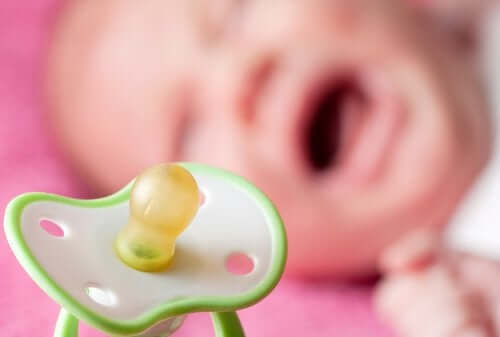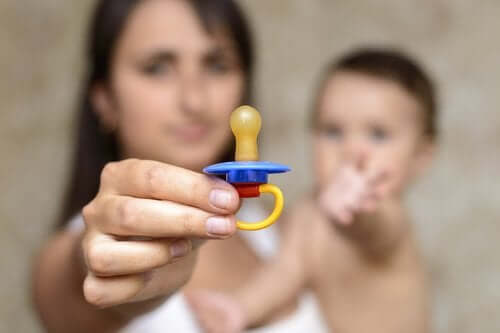Tricks to Get Your Child to Stop Using a Pacifier

Many mothers find it necessary to try some tricks to get their child to stop using a pacifier, as they fervently refuse to stop using it on their own. Are you aware of the most traditional methods?
The use of this implement helps little ones to calm down in their moments of anxiety, in addition to stimulating their appetite and helping them to fall asleep. That’s why, at times, it’s difficult to exclude it permanently from your baby’s life.
However, months go by and the time comes to dispense with this valuable ally, as baby teeth begin to emerge and the constant use of a pacifier can deform them. You have to act fast and firmly in the task of separating your baby from an addictive pacifier.
The success of this mission rests entirely on the patience, level of persuasion, and discipline of the parents. It won’t be an easy job but, definitely, using the right techniques, the goal can be achieved without the child suffering excessively and, consequently, being even more irritable.
8 tricks to get your child to stop using a pacifier
The ideal age for a child to stop using a pacifier isn’t well-defined. Some specialists suggest that its use can be restricted as soon as 9 months.
What’s expected, in general, is that little ones will understand for themself that they no longer need it. If this doesn’t happen naturally, we can try some tricks to achieve this separation.
1. Find the best moment
To implement the pacifier-baby separation plan, you should choose a time when you have enough time to apply it properly. Surely, there will be days of extensive conversations and rounds of surveillance to avoid any relapse. Patience will be the key to success.
2. Open communication
When making the determination that it’s time to give up the pacifier, it’s best to communicate it to your child and not to do it without them being aware of the separation they’re about to face. A good idea is to tell them a story about a similar situation so that they can identify with the circumstances and accept this change with a positive attitude.

3. Special attention to possible crises
Pacifiers are part of the daily life of babies. Those who are hooked on it grow up with that implement and don’t want to stop using it under any circumstances because it becomes part of their lives.
The idea of separating them can lead to many tantrums; At such times, it’s important not to give in. The child will surely cry and ask desperately for their pacifier, but you have to have courage and not succumb to their requests.
4. Find substitutes
Children generally seek the pacifier to calm down or relax. A good idea to promote the separation of your baby and this implement is to replace it with some other object, which could be a toy.
With this change, they see that they’re older and that they deserve things for big kids; Therefore, that pacifier that’s been so important for them will move to another plane and they’ll consider it something that’s “for babies”.
“Months go by and the time comes to dispense with this valuable ally, as baby teeth begin to emerge and the constant use of a pacifier can deform them”
5. Donation
This idea is very practical. You talk to the child and tell them that, now that they’re older, it would be a nice thing to give the pacifier to a smaller child. They usually accept this suggestion quickly; others will think about it a bit, but in the end, they give in just because of the idea of looking older.
6. Teeth
You can explain to your child how important it is to give up the pacifier in order to have healthy teeth when they’re older. For this trick to be more effective, and depending on the age of the infant, it would be excellent to complement this initiative with a visit to the dentist who reaffirms the theory and points out the problems it will bring if the habit continues.
7. Drastic measures
If you notice that the separation process becomes difficult and the infant is uncompromising in giving in, what remains is to take some drastic measures to get your child to stop using a pacifier once and for all. A very popular trick is to make the pacifier less attractive to the child. For example, you can rip the nipple; this way, when they put it in their mouth, they’ll have an unpleasant sensation.

8. Pacifier out of sight
Once the process is underway, the final touch is to make the object in question disappear. You can make up several stories about it: That someone took it or that the pacifier has gone into hiding because it’s tired of being used, for example.
When the attachment to some objects is very intense, it’s best to appeal to creativity and patience to end this relationship. These tricks to remove a baby’s pacifier have worked for generations and are sure to yield good results for a long time to come.
Ultimately, the important thing is to be aware of the fact that this will take time. There will be attitudes and moments that are difficult to control but, with a lot of patience, dedication, and effort, you’ll achieve your objective.
Many mothers find it necessary to try some tricks to get their child to stop using a pacifier, as they fervently refuse to stop using it on their own. Are you aware of the most traditional methods?
The use of this implement helps little ones to calm down in their moments of anxiety, in addition to stimulating their appetite and helping them to fall asleep. That’s why, at times, it’s difficult to exclude it permanently from your baby’s life.
However, months go by and the time comes to dispense with this valuable ally, as baby teeth begin to emerge and the constant use of a pacifier can deform them. You have to act fast and firmly in the task of separating your baby from an addictive pacifier.
The success of this mission rests entirely on the patience, level of persuasion, and discipline of the parents. It won’t be an easy job but, definitely, using the right techniques, the goal can be achieved without the child suffering excessively and, consequently, being even more irritable.
8 tricks to get your child to stop using a pacifier
The ideal age for a child to stop using a pacifier isn’t well-defined. Some specialists suggest that its use can be restricted as soon as 9 months.
What’s expected, in general, is that little ones will understand for themself that they no longer need it. If this doesn’t happen naturally, we can try some tricks to achieve this separation.
1. Find the best moment
To implement the pacifier-baby separation plan, you should choose a time when you have enough time to apply it properly. Surely, there will be days of extensive conversations and rounds of surveillance to avoid any relapse. Patience will be the key to success.
2. Open communication
When making the determination that it’s time to give up the pacifier, it’s best to communicate it to your child and not to do it without them being aware of the separation they’re about to face. A good idea is to tell them a story about a similar situation so that they can identify with the circumstances and accept this change with a positive attitude.

3. Special attention to possible crises
Pacifiers are part of the daily life of babies. Those who are hooked on it grow up with that implement and don’t want to stop using it under any circumstances because it becomes part of their lives.
The idea of separating them can lead to many tantrums; At such times, it’s important not to give in. The child will surely cry and ask desperately for their pacifier, but you have to have courage and not succumb to their requests.
4. Find substitutes
Children generally seek the pacifier to calm down or relax. A good idea to promote the separation of your baby and this implement is to replace it with some other object, which could be a toy.
With this change, they see that they’re older and that they deserve things for big kids; Therefore, that pacifier that’s been so important for them will move to another plane and they’ll consider it something that’s “for babies”.
“Months go by and the time comes to dispense with this valuable ally, as baby teeth begin to emerge and the constant use of a pacifier can deform them”
5. Donation
This idea is very practical. You talk to the child and tell them that, now that they’re older, it would be a nice thing to give the pacifier to a smaller child. They usually accept this suggestion quickly; others will think about it a bit, but in the end, they give in just because of the idea of looking older.
6. Teeth
You can explain to your child how important it is to give up the pacifier in order to have healthy teeth when they’re older. For this trick to be more effective, and depending on the age of the infant, it would be excellent to complement this initiative with a visit to the dentist who reaffirms the theory and points out the problems it will bring if the habit continues.
7. Drastic measures
If you notice that the separation process becomes difficult and the infant is uncompromising in giving in, what remains is to take some drastic measures to get your child to stop using a pacifier once and for all. A very popular trick is to make the pacifier less attractive to the child. For example, you can rip the nipple; this way, when they put it in their mouth, they’ll have an unpleasant sensation.

8. Pacifier out of sight
Once the process is underway, the final touch is to make the object in question disappear. You can make up several stories about it: That someone took it or that the pacifier has gone into hiding because it’s tired of being used, for example.
When the attachment to some objects is very intense, it’s best to appeal to creativity and patience to end this relationship. These tricks to remove a baby’s pacifier have worked for generations and are sure to yield good results for a long time to come.
Ultimately, the important thing is to be aware of the fact that this will take time. There will be attitudes and moments that are difficult to control but, with a lot of patience, dedication, and effort, you’ll achieve your objective.
All cited sources were thoroughly reviewed by our team to ensure their quality, reliability, currency, and validity. The bibliography of this article was considered reliable and of academic or scientific accuracy.
- Asociación Española de Pediatría. Uso del chupete y lactancia materna. 2011. Disponible en: https://www.aeped.es/comite-lactancia-materna/documentos/uso-chupete-y-lactancia-materna
- Álvarez Hernández, C., Barcia Varas, J., Pavez Gallegos, N., & Zúñiga Delgado, C. (2015). Descripción de reflejos orofaciales, succión nutritiva y no nutritiva en lactantes prematuros extremos de 3 y 6 meses de edad corregida. http://repositorio.uchile.cl/bitstream/handle/2250/138230/Álvarez%20Barcia%20Pavez%20Zúñiga.pdf?sequence=1&isAllowed=y
- Diaz Coronado, V. N. (2018). EFICACIA DEL USO DEL CHUPETE EN LA DISMINUCIÓN DE LA MUERTE SÚBITA EN LACTANTES. http://repositorio.uwiener.edu.pe/bitstream/handle/123456789/2026/ESPECIALIDAD%20-%20Diaz%20Coronado%2c%20Vilma%20Nerida.pdf?sequence=1&isAllowed=y
- Asociación Española de Pediatría. (n.d.). Chupere. https://enfamilia.aeped.es/edades-etapas/chupete
- Varas, V. F., & Gil, B. G. (2012, December). Hábito de succión del chupete y alteraciones dentarias asociadas. Importancia del diagnóstico precoz. In Anales de Pediatría (Vol. 77, No. 6, pp. 374-380). Elsevier Doyma. https://www.google.com/url?sa=t&rct=j&q=&esrc=s&source=web&cd=&cad=rja&uact=8&ved=2ahUKEwir6Ijqxv_rAhUF2uAKHd25C2MQFjACegQIBRAB&url=https%3A%2F%2Fwww.analesdepediatria.org%2Findex.php%3Fp%3Drevista%26tipo%3Dpdf-simple%26pii%3DS1695403312001518&usg=AOvVaw34bQh3N6vKYwbb2nh6idzq
- Sánchez, L. M., González, E. D., Florensa, S. G. T., & Marti, J. G. (2000, January). Uso del chupete: beneficios y riesgos. In Anales de Pediatría (Vol. 53, No. 6, pp. 580-585). Elsevier Doyma. https://www.analesdepediatria.org/es-pdf-S1695403300775023
This text is provided for informational purposes only and does not replace consultation with a professional. If in doubt, consult your specialist.








